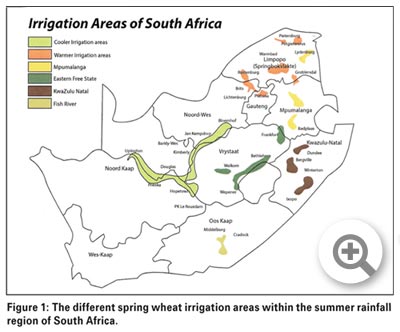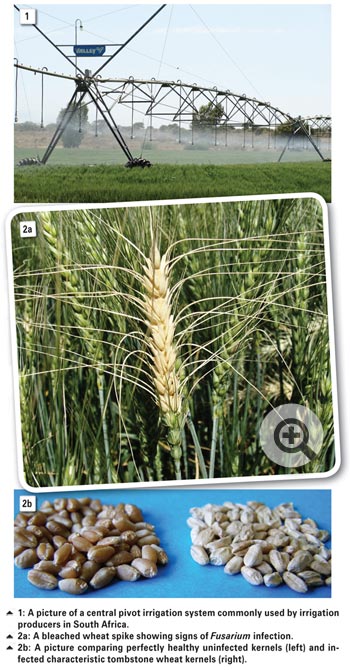June 2014
SCOTT SYDENHAM and CATHY DE VILLIERS, ARC-Small Grain Institute
In this article we discuss the recent undertaking at the ARC-Small Grain Institute (ARC-SGI) to develop diverse Fusarium head blight and Deoxynivalenol resistant wheat germplasm for the South African wheat industry in a targeted pre-breeding programme.
 Fusarium head blight, also known as scab, is one of the most destructive diseases of wheat. Fusarium graminearum (Gibberella zeae) is the predominant causal organism on wheat and barley. In South Africa, Fusarium head blight is predominantly caused by Fusarium graminearium and has become an increasing concern for producers/researchers within the expanding irrigation areas.
Fusarium head blight, also known as scab, is one of the most destructive diseases of wheat. Fusarium graminearum (Gibberella zeae) is the predominant causal organism on wheat and barley. In South Africa, Fusarium head blight is predominantly caused by Fusarium graminearium and has become an increasing concern for producers/researchers within the expanding irrigation areas.
The most prevalent casual Fusarium species within a specific production area are restricted to specific geographical regions and climatic conditions. Considering global climate change, adoption of different tillage practices and an increase in irrigated wheat production areas, Fusarium head blight has spread into new and different wheat production areas.
A continual concern with the increased production of irrigated wheat is the potential for Fusarium head blight epidemics. There are a number of different spring wheat irrigation production areas across South Africa and within the different provinces, namely cooler irrigation, warmer irrigation, Mpumalanga, Eastern Free State, KwaZulu-Natal and Fish River irrigation production areas (Figure 1).
In South Africa there are various different climatic conditions and micro-environments created which are also dependent on irrigation systems and water sources used that play a role in Fusarium head blight disease development across the various irrigation production areas (Photo 1).
 In South Africa, Fusarium head blight can be severe under high inoculum pressure in combination with the planting of highly susceptible cultivars, high moisture availability during anthesis, maize-wheat crop rotation and conservation agriculture practices.
In South Africa, Fusarium head blight can be severe under high inoculum pressure in combination with the planting of highly susceptible cultivars, high moisture availability during anthesis, maize-wheat crop rotation and conservation agriculture practices.
Yield losses of up to 50% are possible on susceptible cultivars grown under conditions which are optimal for Fusarium head blight disease development. Characteristic Fusarium head blight symptoms are white bleached spikes and curled-out awns just after flowering (Photo 2a).
Apart from the disease reducing the crop yield, grain can be damaged (tombstone kernels) and contaminated with mycotoxins, such as Deoxynivalenol, (Photo 2b).
This damage to the grain will affect the grading that can be obtained, which will significantly influence potential profits for producers.
Retained seed infected with Fusarium could reduce seed germination and increase the incidence of root rot and seedling blight as well. Infected kernels may contain mycotoxins which are produced by certain Fusarium species which are hazardous to humans as well as animals after consumption. For this reason, Fusarium mycotoxins have also been studied for their involvement in pathogenicity (aggressiveness) of the fungus during infection.
The best management method of Fusarium head blight is an integrated method, involving better management of both crop rotation and no-till practices, built around the planting of resistant cultivars. The most environmentally responsible and efficient long-term method for Fusarium head blight control is resistant cultivars with host plant resistance. There are different types of Fusarium head blight resistance which have been documented that make up the Fusarium head blight disease complex. Type I resistance provides resistance to initial infection by the pathogen; Type II is resistance against the spread of Fusarium infection within the wheat head and the accumulation of mycotoxins such as Deoxynivalenol.
For a number of years a well-documented Fusarium head blight resistance source, Sumai 3, has been used in several breeding programmes around the world to provide resistant wheat varieties. Sumai 3 contains important Fusarium head blight resistance genes/QTL which can be targeted with specific DNA markers that are linked to resistance genes.
The Fhb1 gene, originating from Sumai 3 is one gene which has been used throughout the world in the development of Fusarium head blight resistant wheat varieties. Another popular moderately resistant source used is the Brazilian wheat cultivar, Frontana. In recent years, a number of novel Asian Fusarium head blight resistance sources have been characterised and documented, namely: Asozaira, Baisanyuehuang, Huangcandou, Huangfangzhu, Haiyanzhong, Ning 7840, Yang Mai, Wan Nian 2 and Wangshuibai.
Also including CIMMYT derived material, such as CM-82036 and recently, Catbird. The major challenge with these foreign donors is that they are not adapted to South African conditions and a number of negative effects on yield, quality and other agronomical traits were reported to be associated with these sources.
There is a need in South Africa for the development of diverse Fusarium head blight resistant wheat germplasm. A newly funded Winter Cereal Trust pre-breeding project with this unique need in mind was initiated by the ARC in April 2013.
This pre-breeding programme focuses predominantly on DNA markers linked to Type I and Type II Fusarium head blight resistance genes/QTL with stable expression across environments and genetic backgrounds. In South Africa there are currently limited Fusarium head blight resistant wheat cultivars commercially available. This is compounded by the fact that no fungicide is officially registered for the control of Fusarium head blight on wheat.
The aim of this pre-breeding programme is to make use of phenotypic and marker-assisted based backcross, to develop diverse Fusarium head blight and Deoxynivalenol resistant wheat germplasm for the South African wheat industry.
A focused breeding effort is to combine different Fusarium head blight resistance genes/QTL from multiple Fusarium head blight resistant donors obtained from the different corners of the world into South African wheat germplasm.
With a directed focus on the responsible deployment of different Fusarium head blight resistance gene/QTL combinations to confer broad and durable resistance against the Fusarium graminearium species complex. Ultimately, advanced lines with different Fusarium head blight resistance gene/QTL combinations which can be used for more efficient transfer into elite breeding material, will be developed.
Over the last year, this programme has already imported twelve different Fusarium head blight resistance donors for use in a specific crossing block. These Fusarium head blight resistant donors have been validated phenotypically in a field trial near Bethlehem together with other promising Fusarium head blight resistant donors.
The resistant donors were planted in a hill plot design and inoculated by spray inoculation methods during flowering with a cocktail of different Fusarium isolates. The inoculated heads were covered by plastic bags to increase humidity (Photo 3). The donors were screened after 28 days to determine their resistance levels (Photo 4).
To further confirm resistance in these donors, a glasshouse trial by artificial point inoculation method with a cocktail of different Fusarium isolates is conducted. Each one of the validated Fusarium head blight resistance donors (male parent) will then be crossed in a one directional manner to South African wheat varieties (female parent) adapt for irrigation conditions.
Once the lines are advanced to BC2 and BC3 generations, they will be evaluated in the field under irrigation in two meter rows at Bethlehem, South Africa. After the second year annual Fusarium head blight resistance nurseries will be publicly released to the South African wheat industry for use by all breeding companies.
After the third year the first formal germplasm registration and international release will be made of specific lines containing high Fusarium head blight resistance and Deoxynivalenol resistance levels within specific South African cultivar backgrounds. Ultimately, it is expected in the years to come that a number of commercially released Fusarium head blight resistant spring wheat irrigation cultivars will become available in South Africa directly as a result of this diverse pre-breeding programme carried out at the ARC-SGI, Bethlehem campus.
These cultivars should then be used in combination with other control practices to successfully control potential future Fusarium head blight epidemics. This pre-breeding programme is the beginning of the forthcoming development of diverse Fusarium head blight resistant germplasm.
For any questions, please contact Scott Sydenham or Cathy de Villiers at 058 307 3400.
Publication: June 2014
Section: Input Overview